Cycling is a fantastic activity, whether you’re commuting, training, or enjoying a leisurely ride. However, being comfortable on your bike means dressing appropriately for the weather conditions. Choosing the right Clothing For Bike Riding can significantly impact your performance and enjoyment. This guide, inspired by insights from cycling coach David Ertl, will help you select the best cycling apparel for various temperatures, ensuring you’re perfectly geared up for any ride.
Decoding Cycling Apparel for Different Temperatures
Finding the perfect balance of warmth and breathability is key to comfortable cycling. What you wear can make the difference between an enjoyable ride and an uncomfortable, potentially unsafe one. Let’s break down the recommended clothing for bike riding across a range of temperatures, moving from warm to cold conditions.
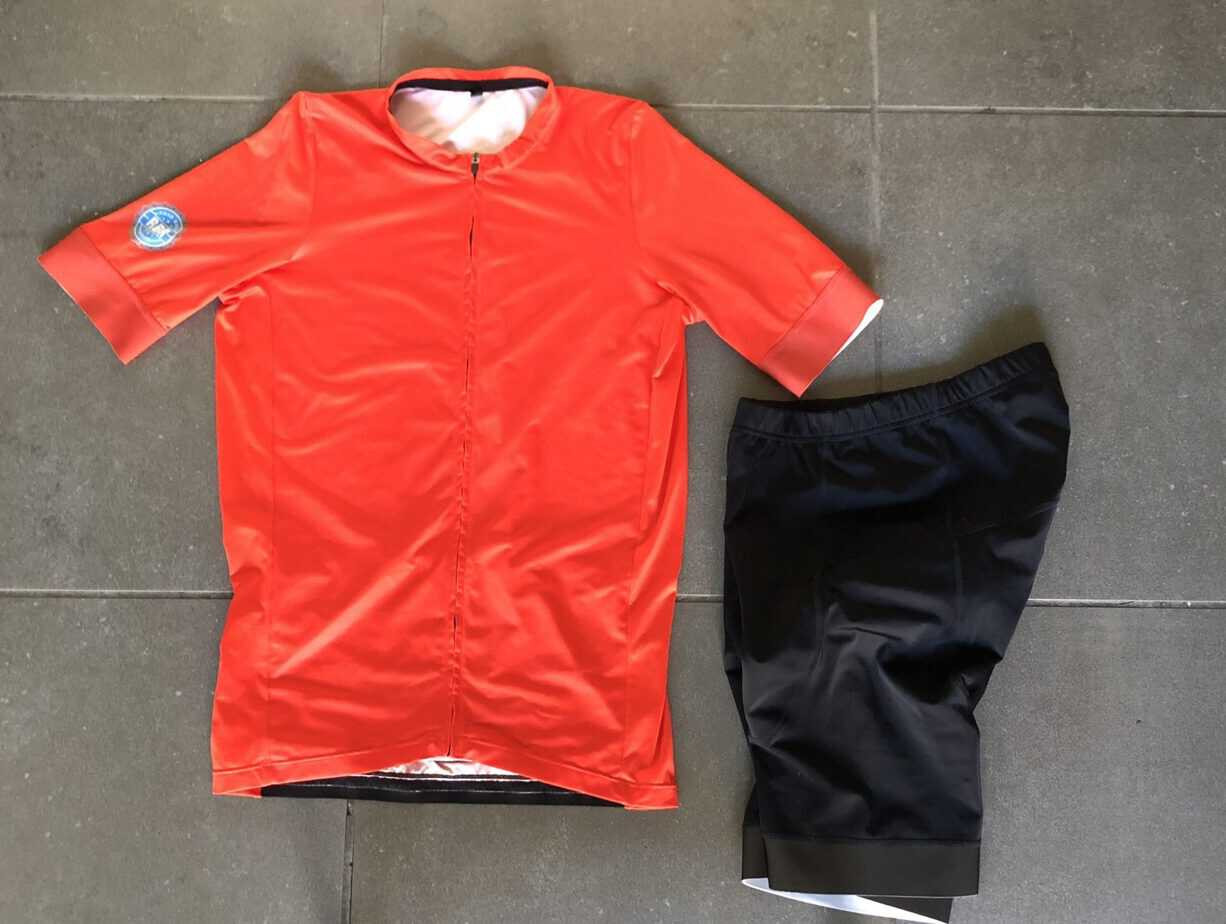 Cyclist in appropriate clothing for 70 degrees Fahrenheit
Cyclist in appropriate clothing for 70 degrees Fahrenheit
70 Degrees Fahrenheit (21 Degrees Celsius): Summer Cycling Kit
When the temperature hits 70 degrees, it’s time for your summer cycling wardrobe. The ideal clothing for bike riding in this warmth is simple and breathable:
- Bottoms: Cycling shorts are the standard choice. They offer comfort with padding and allow for maximum ventilation.
- Top: A short-sleeve cycling jersey is perfect. Look for jerseys made from moisture-wicking fabrics to keep you cool and dry as you sweat.
At this temperature, you generally don’t need any extra layers for your head, hands, or feet unless you are particularly sensitive to temperature changes.
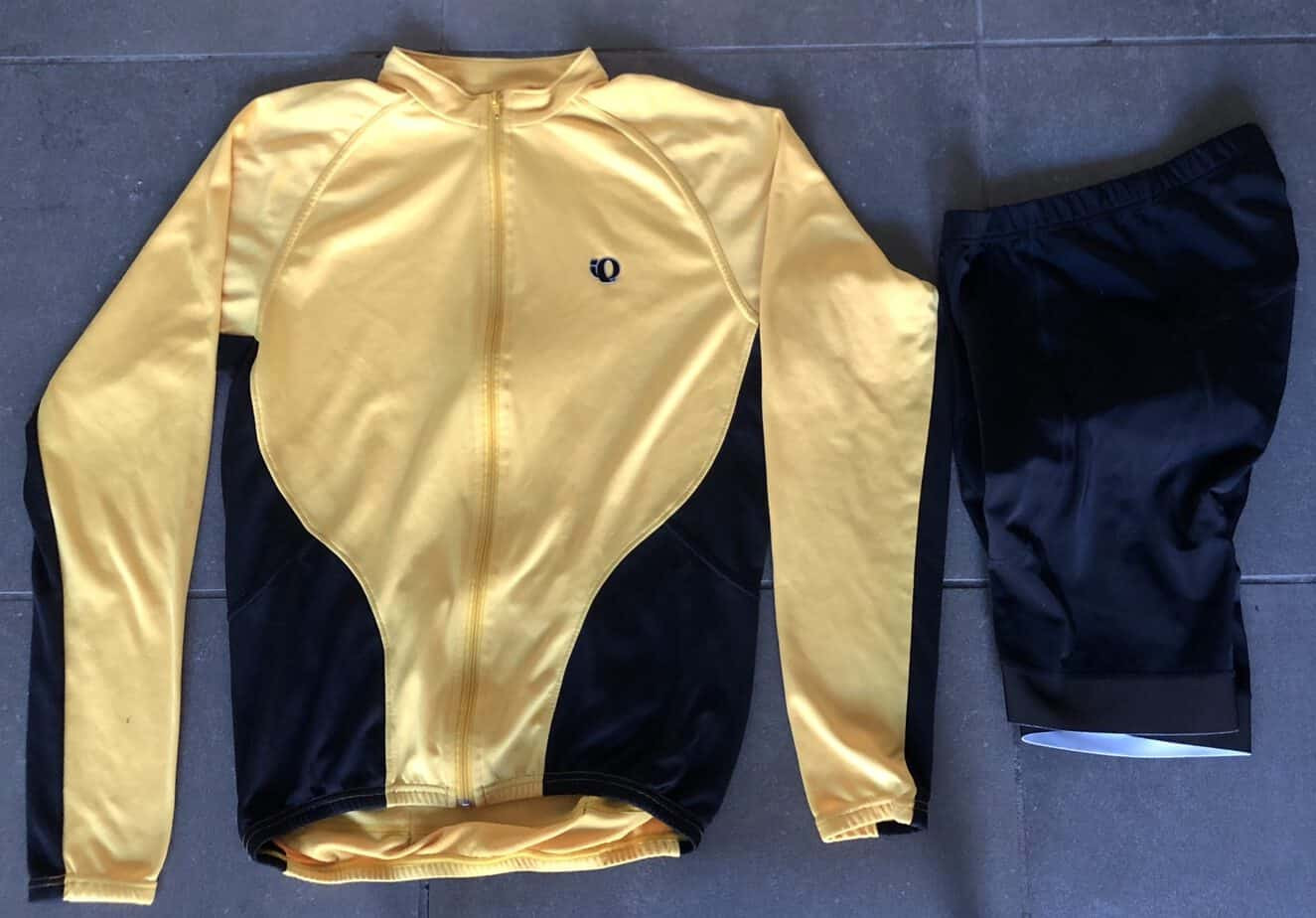 Cyclist wearing 60 degrees cycling kit
Cyclist wearing 60 degrees cycling kit
60 Degrees Fahrenheit (15.5 Degrees Celsius): Light Layers for Mild Weather
As the temperature drops to 60 degrees, you’ll want to add a bit more coverage while still maintaining breathability. Good clothing for bike riding at this temperature includes:
- Bottoms: Continue with cycling shorts, or consider adding leg warmers for a bit more warmth, especially at the start of your ride or if you are sensitive to cooler temperatures.
- Top: A long-sleeve jersey becomes a good option. Alternatively, you could wear a short-sleeve jersey with a thin, long-sleeve base layer underneath. A base layer helps wick away moisture while providing a touch of added warmth.
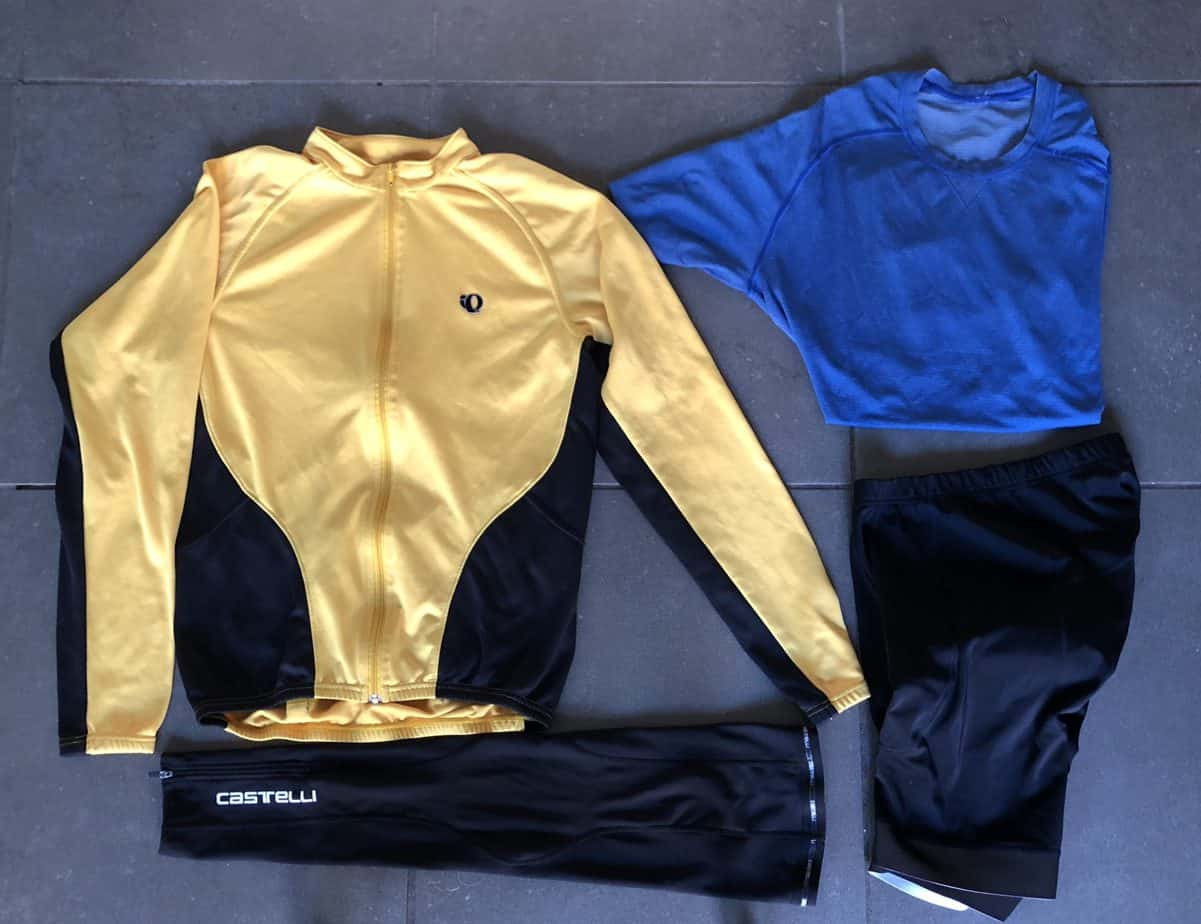 Cyclist dressed for 50 degrees Fahrenheit cycling
Cyclist dressed for 50 degrees Fahrenheit cycling
50 Degrees Fahrenheit (10 Degrees Celsius): Mid-Range Cycling Apparel
Fifty degrees marks the transition to cooler riding conditions. Layering becomes increasingly important to manage your body temperature effectively. Clothing for bike riding in 50-degree weather should include:
- Bottoms: Tights or leg warmers are essential. Tights provide full leg coverage and warmth, while leg warmers can be paired with shorts for flexibility.
- Top: You have a few options here. A heavy long-sleeve jersey worn with a sleeveless or short-sleeve wicking base layer provides good insulation. Another option is a lightweight long-sleeve jersey combined with a long-sleeve base layer. The key is to have a wicking base layer to manage sweat under a warmer outer layer.
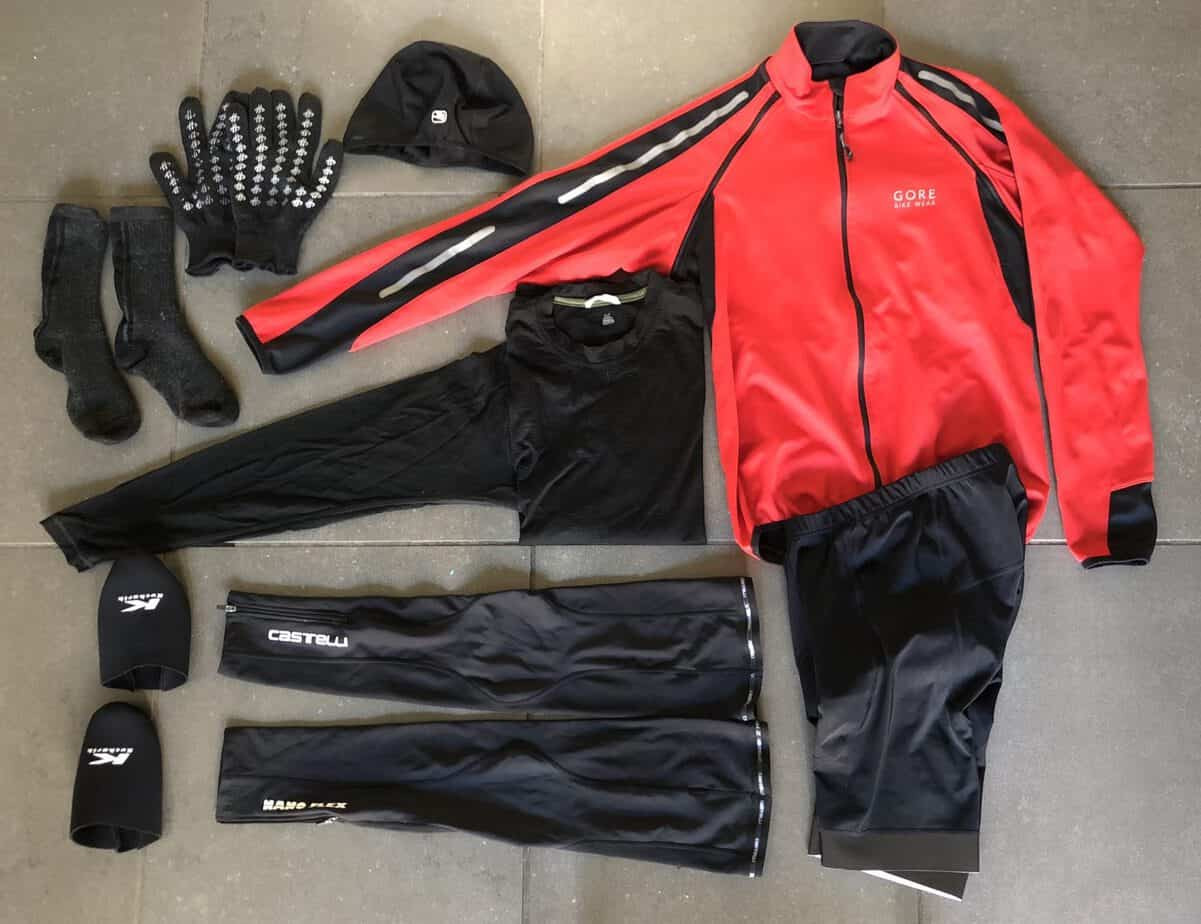 Cyclist in clothing suitable for 45 degrees Fahrenheit
Cyclist in clothing suitable for 45 degrees Fahrenheit
45 Degrees Fahrenheit (7 Degrees Celsius): Adding Outerwear and Accessories
At 45 degrees, you’ll need to incorporate more specialized cycling clothing to stay comfortable. This is where accessories become crucial. Recommended clothing for bike riding in 45-degree weather is:
- Bottoms: Tights or leg warmers continue to be necessary.
- Top: A long-sleeve wicking base layer paired with a lined cycling jacket is ideal. The base layer manages moisture, while the jacket provides wind protection and insulation.
- Hands: Thin full-fingered gloves are needed to protect your hands from the cold and wind chill.
- Head and Ears: A headband that covers your ears is important to prevent heat loss and keep your ears warm.
- Feet: Wool socks and shoe covers are recommended to keep your feet warm and dry.
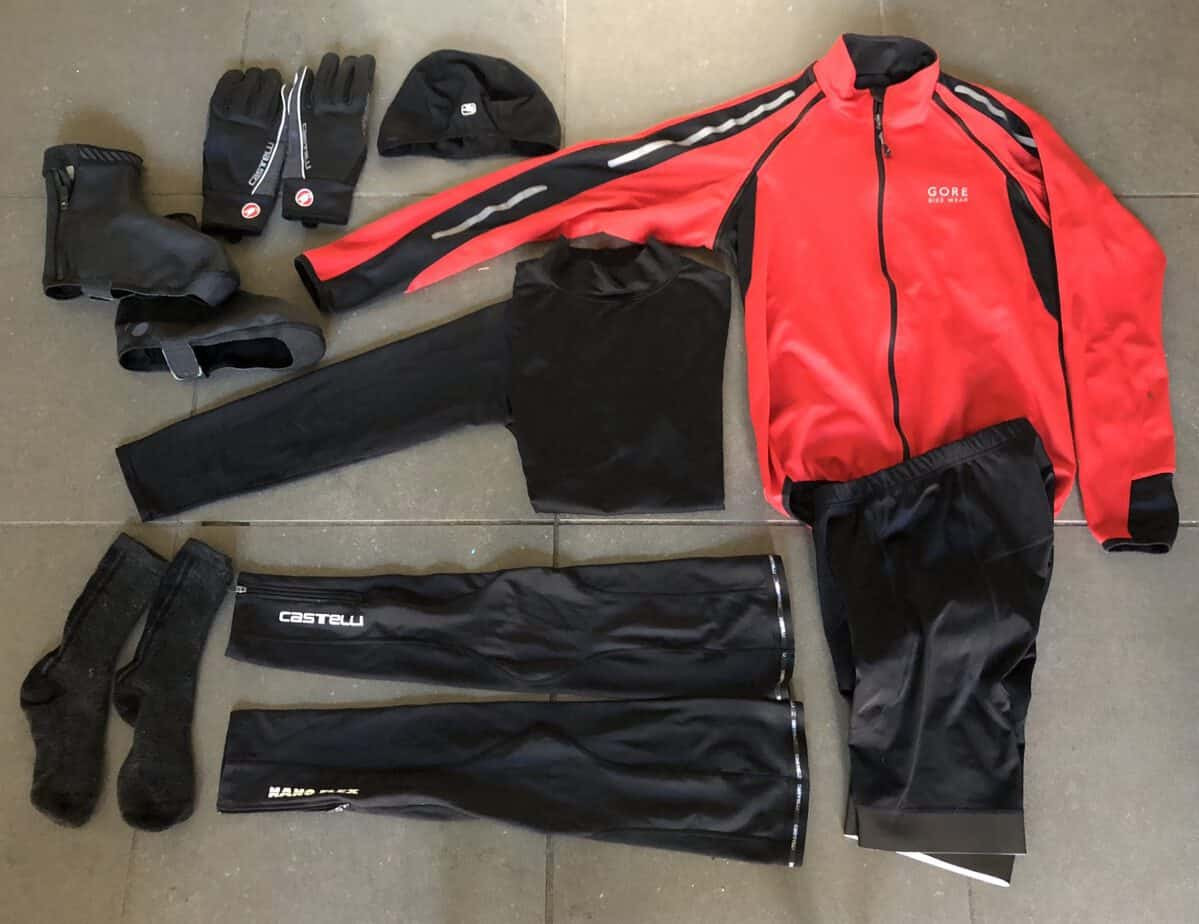 Appropriate cycling clothing for 40 degrees Fahrenheit
Appropriate cycling clothing for 40 degrees Fahrenheit
40 Degrees Fahrenheit (4.4 Degrees Celsius): Stepping Up the Insulation
As you approach 40 degrees, maximizing warmth while still managing moisture is the goal. Clothing for bike riding in 40-degree conditions needs to be warmer and more protective:
- Bottoms: Tights or leg warmers remain essential.
- Top: A long-sleeve heavy mock turtleneck base layer (like Under Armour) combined with a lined cycling jacket provides significant warmth. The mock turtleneck adds extra insulation around the neck.
- Hands: Medium-weight gloves are necessary to keep your hands warm in these colder conditions.
- Head and Ears: Continue using a headband to cover your ears.
- Feet: Winter cycling shoes, shoe covers, and wool socks are crucial for keeping your feet warm and dry. Winter cycling shoes are designed with better insulation than standard cycling shoes.
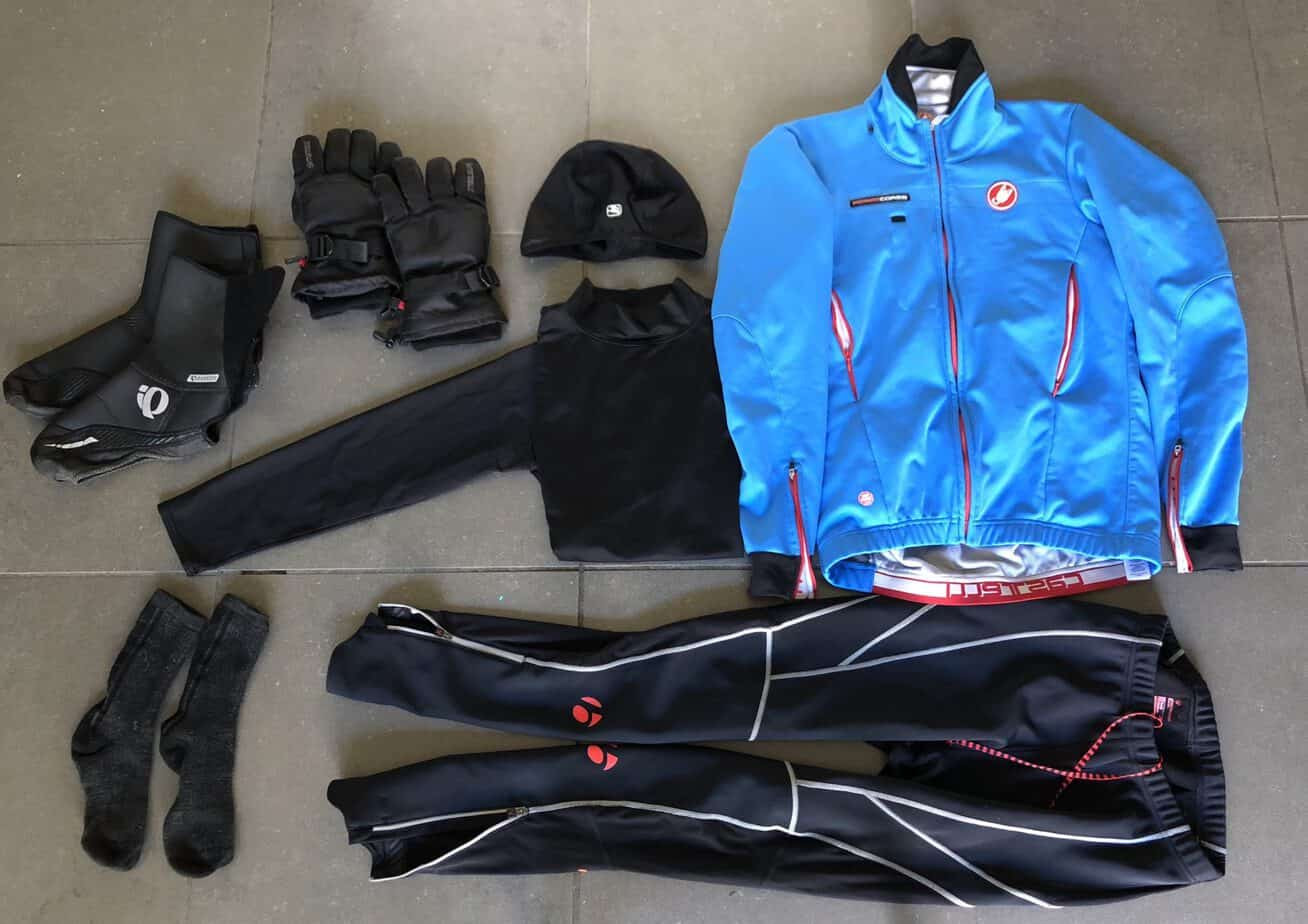 Cyclist wearing 35 degree clothing for cold weather cycling
Cyclist wearing 35 degree clothing for cold weather cycling
35 Degrees Fahrenheit (1.7 Degrees Celsius): Heavy-Duty Cold Weather Gear
Thirty-five degrees and below requires serious cold-weather cycling gear. At this temperature, preventing heat loss and protecting extremities is paramount. Essential clothing for bike riding in 35-degree weather includes:
- Bottoms: Heavyweight tights provide maximum insulation for your legs.
- Top: A long-sleeve heavy wicking turtleneck base layer and a heavy cycling jacket are necessary for core warmth and moisture management.
- Hands: Heavyweight gloves are essential to protect your hands from freezing temperatures and wind.
- Head and Ears: A headband covering your ears is still important.
- Feet: Winter cycling shoes, shoe covers, wool socks, and charcoal toe warmers are highly recommended. Toe warmers provide extra heat for your toes, which are often the first to get cold.
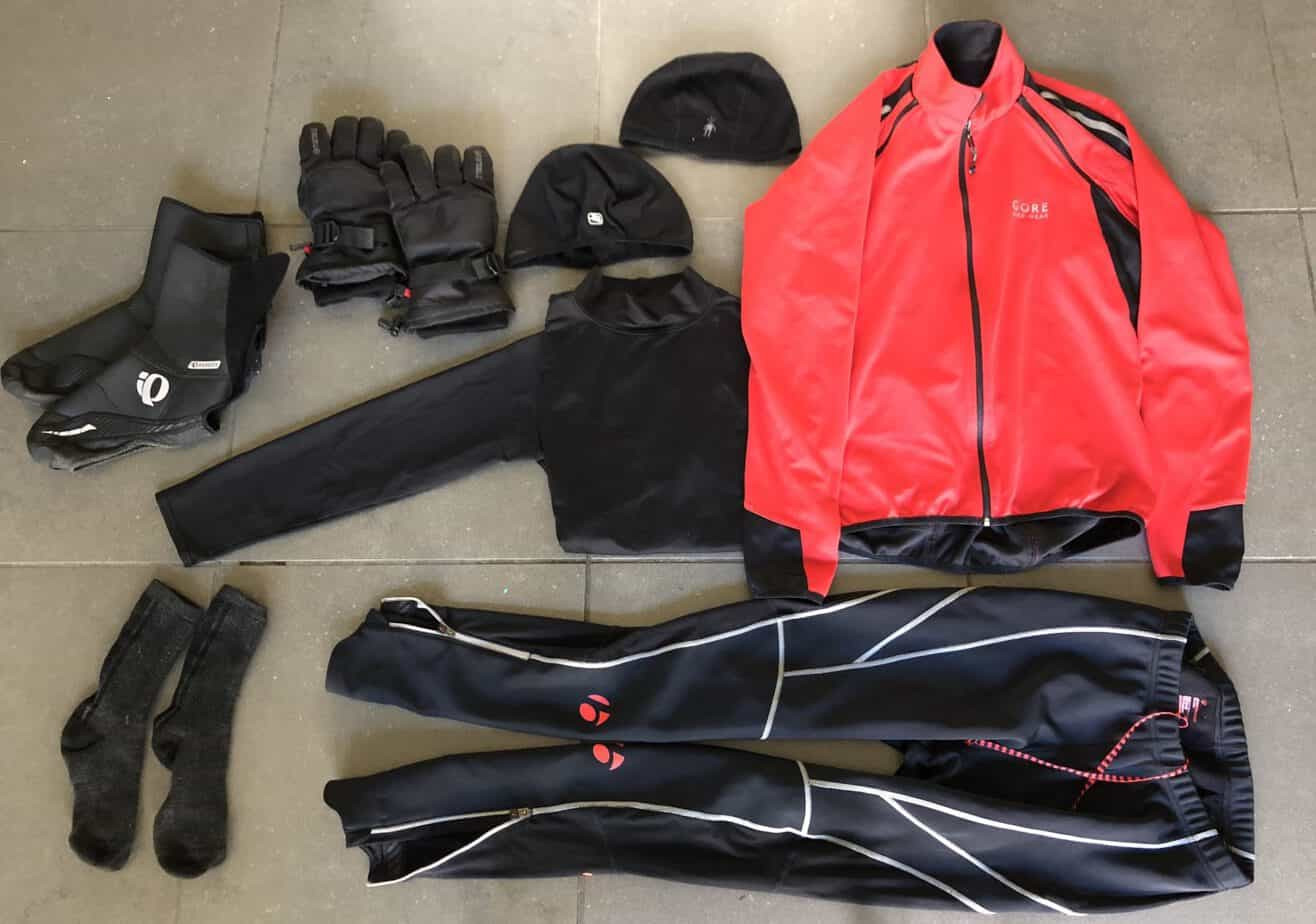 Cycling apparel list for 30 degree weather
Cycling apparel list for 30 degree weather
30 Degrees Fahrenheit (-1 Degree Celsius): Extreme Cold Cycling Outfits
When the temperature drops to 30 degrees, you are entering extreme cold cycling conditions. Clothing for bike riding in 30-degree weather needs to offer maximum protection against the cold:
- Bottoms: Heavyweight tights are still the choice for bottom insulation.
- Top: A long-sleeve heavy wicking turtleneck base layer and a heavy cycling jacket continue to be crucial.
- Hands: Heavyweight gloves are essential.
- Head: A lined skullcap is needed to provide more insulation for your head than just a headband.
- Feet: Winter cycling shoes, shoe covers, wool socks, and charcoal toe warmers remain essential for keeping your feet warm.
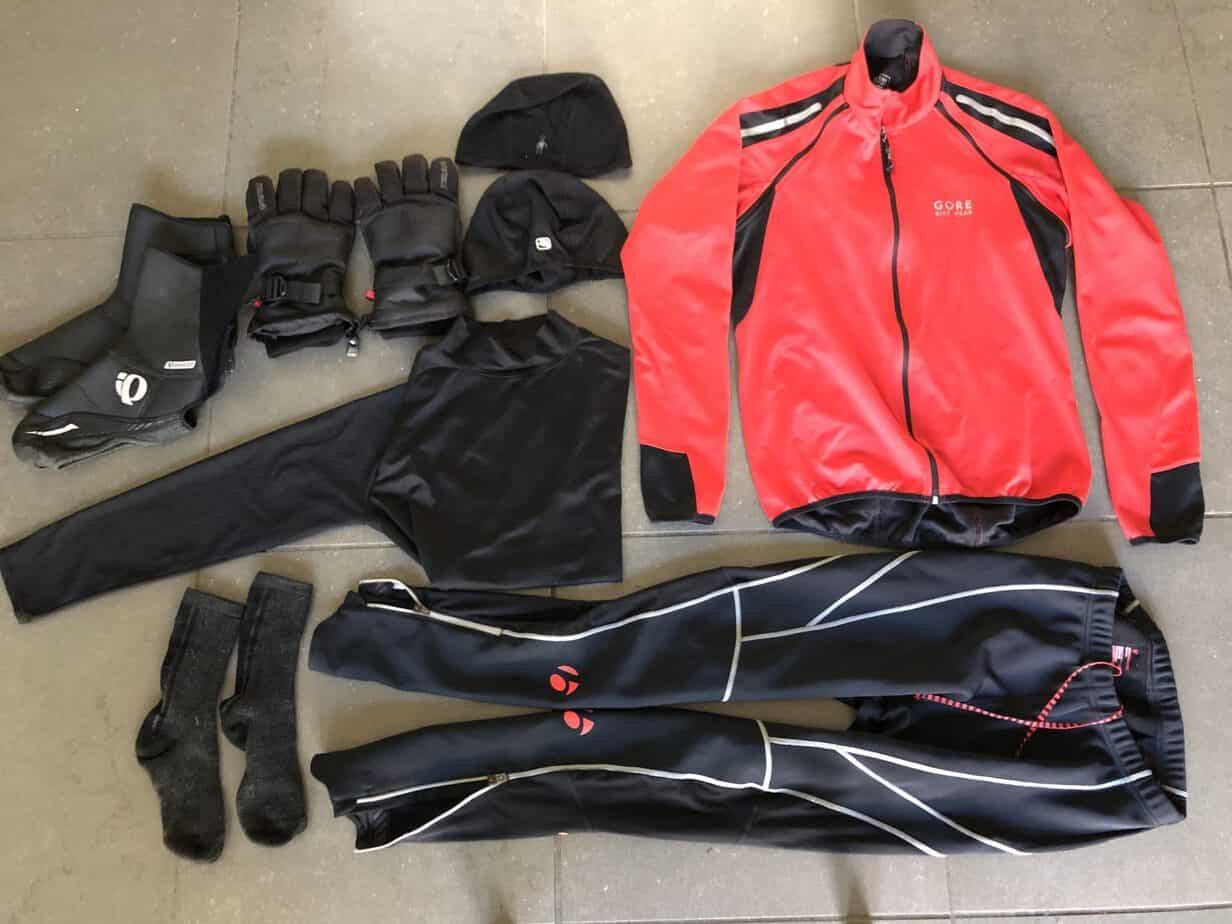 What to wear on a road bike in 25 degrees Fahrenheit
What to wear on a road bike in 25 degrees Fahrenheit
25 Degrees Fahrenheit (-3.9 Degrees Celsius): Sub-Freezing Cycling Gear
Cycling in 25-degree weather requires specialized winter cycling gear to combat sub-freezing temperatures. Clothing for bike riding at 25 degrees and below needs to be the warmest and most protective available:
- Bottoms: Winter bib tights offer superior warmth and coverage compared to standard tights, preventing gaps at the waist.
- Top: Layering is key. A long-sleeve heavy wicking full turtleneck base layer, a long-sleeve jersey, and a lined cycling jacket provide a comprehensive system for warmth and moisture management.
- Hands: Mittens or lobster claw gloves offer more warmth than standard gloves in extreme cold. Mittens keep your fingers together for maximum heat retention, while lobster claw gloves offer a compromise between mittens and gloves, providing some dexterity.
- Head: A balaclava is essential to cover your entire head and neck, leaving only your eyes exposed, for maximum protection against the cold.
- Feet: Winter cycling shoes, wool socks, plastic bags (as a vapor barrier), and charcoal toe warmers are all crucial for keeping your feet warm and dry. Plastic bags inside your shoes can help trap warmth and block moisture from sweat.
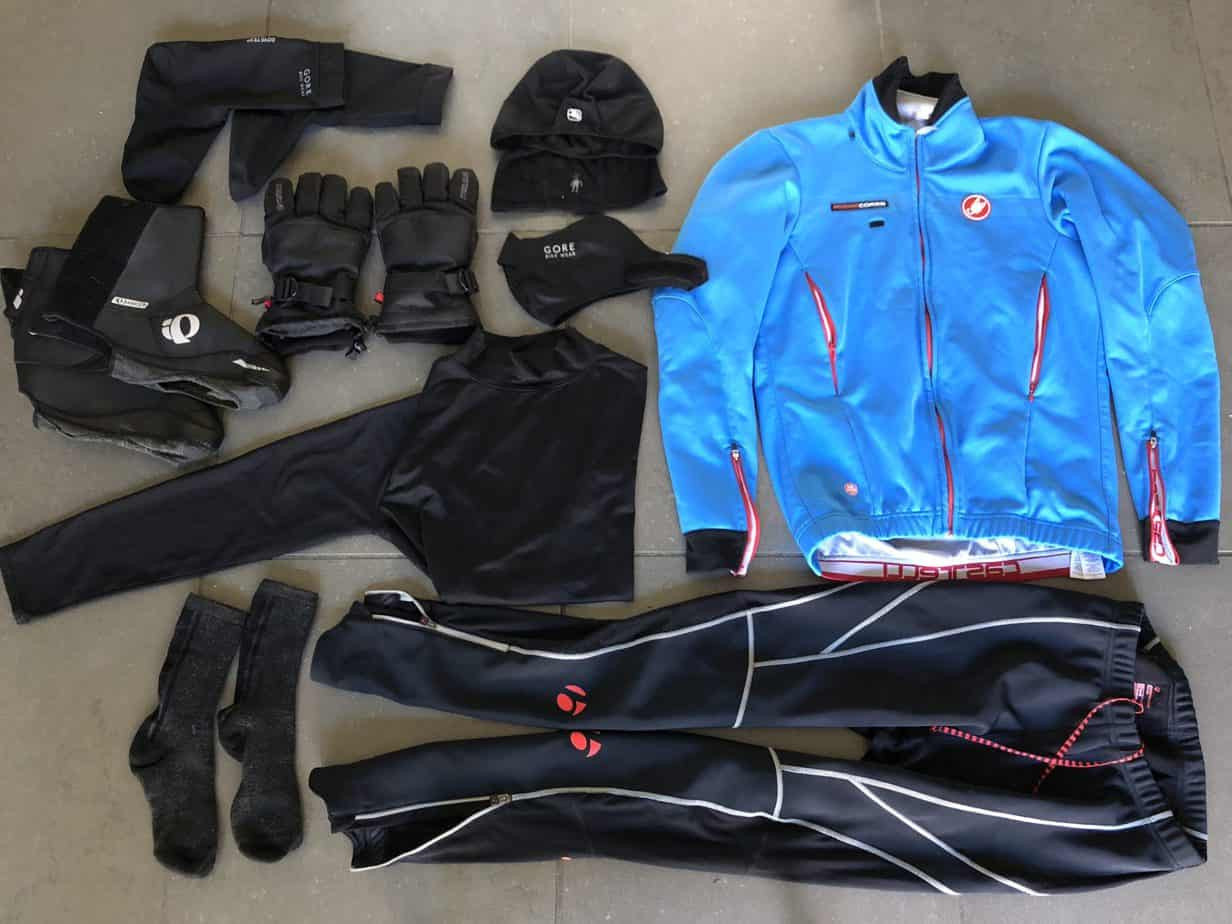 Outfit for road cycling in 20 degrees Fahrenheit and below
Outfit for road cycling in 20 degrees Fahrenheit and below
20 Degrees Fahrenheit (-6.7 Degrees Celsius) and Below: Extreme Winter Cycling Apparel
For 20 degrees and below, you need the warmest cycling clothing available. The recommendations for 25 degrees largely apply and should be considered essential for clothing for bike riding in these extreme conditions:
- Bottoms: Winter bib tights.
- Top: Long-sleeve heavy wicking full turtleneck base layer, long-sleeve jersey, and lined cycling jacket.
- Hands: Mittens or lobster claw gloves.
- Head: Balaclava.
- Feet: Winter cycling shoes, wool socks, plastic bag vapor barrier, and charcoal toe warmers.
In extremely cold conditions, consider shortening your ride duration and riding at a lower intensity to minimize sweat, which can lead to chilling when you stop.
Personalizing Your Cycling Wardrobe
Remember, these are guidelines. Individual comfort levels vary. Factors like wind, sun exposure, and personal preferences will influence your clothing choices. Experiment to find what works best for you. Layering is key, allowing you to adjust to changing conditions during your ride. Building a comprehensive cycling wardrobe over time will ensure you’re prepared for any temperature, making every ride more enjoyable, no matter the weather.

